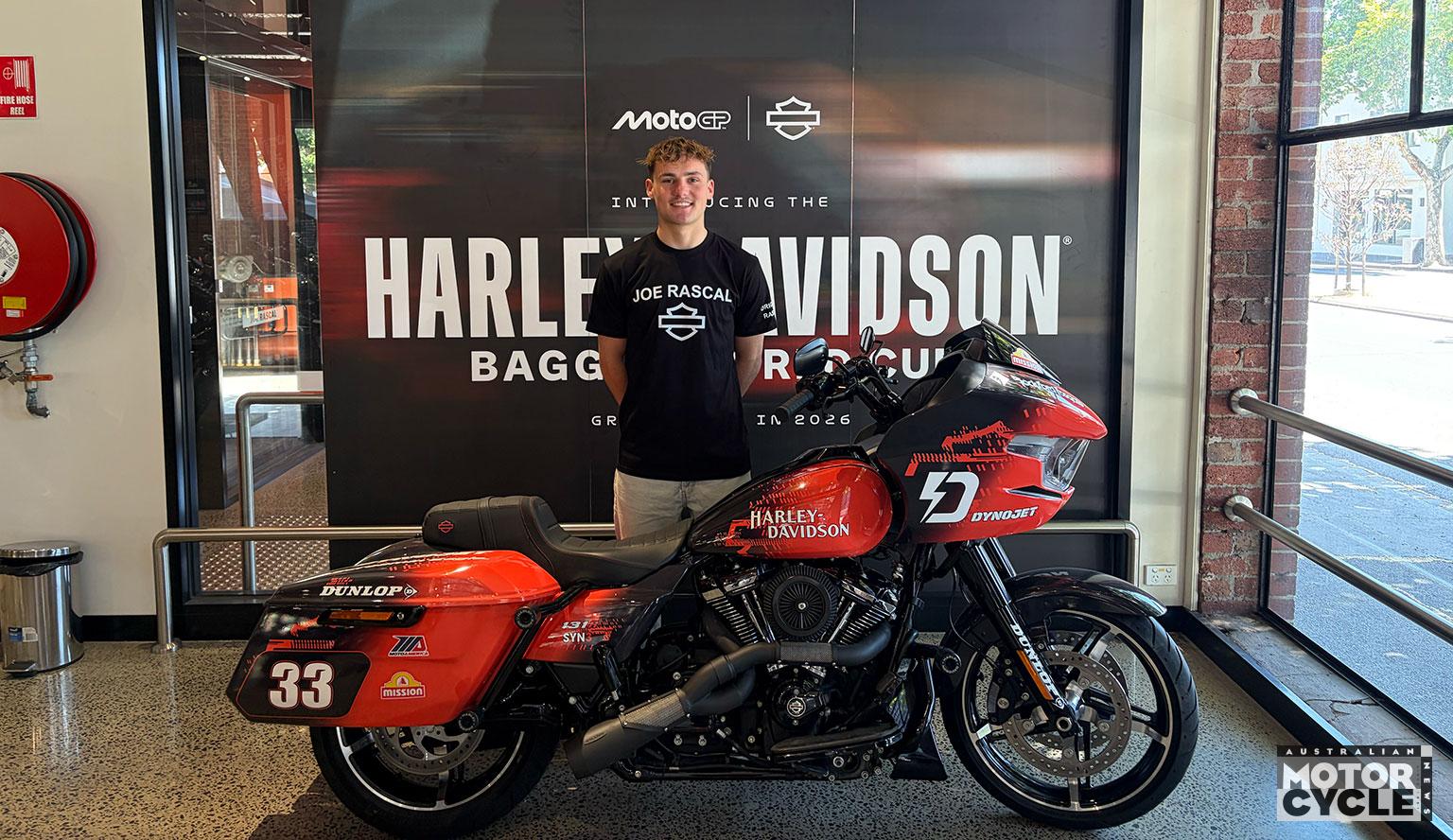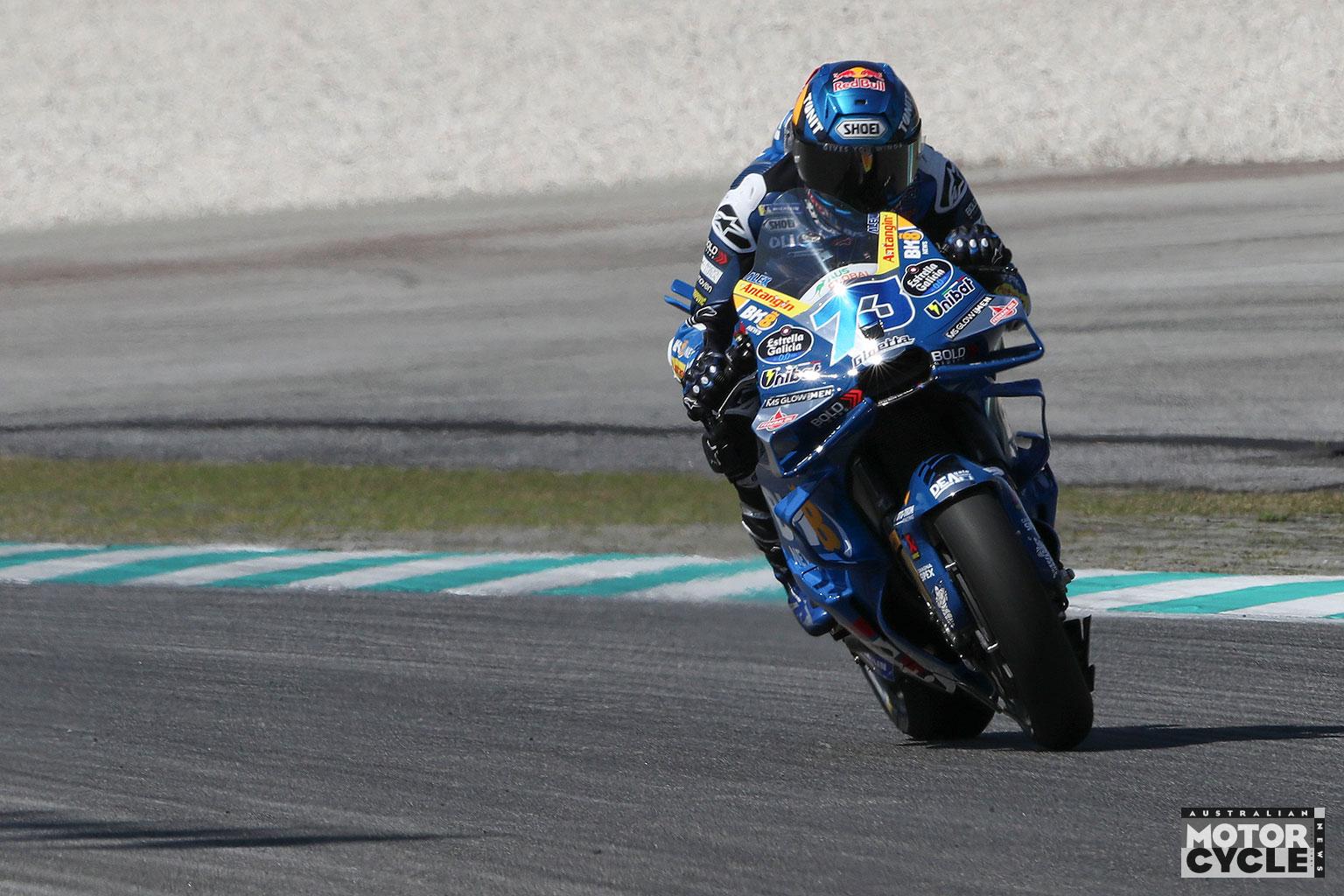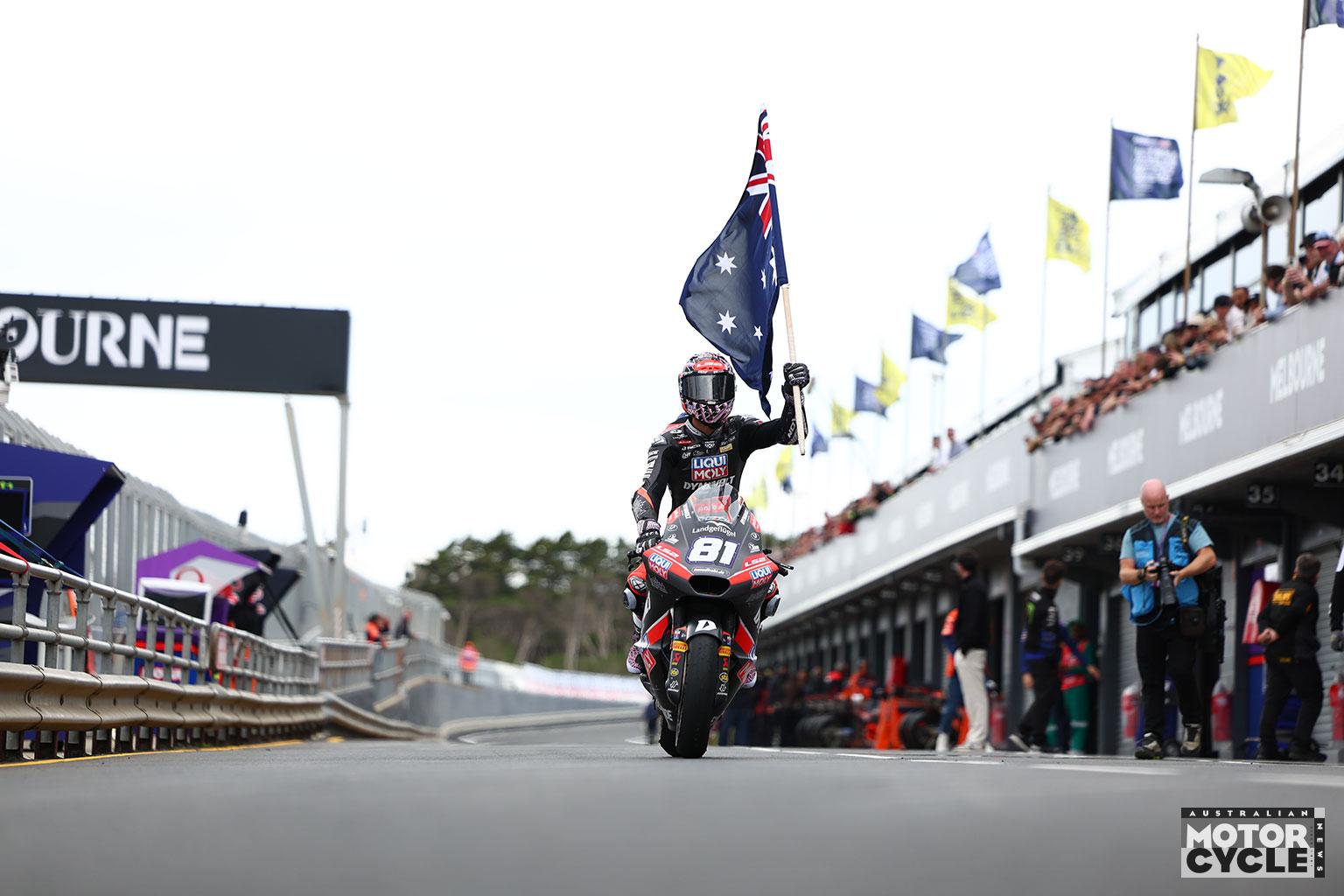Casey’s first steps
SEASON: 2001
Casey was racing in Britain and especially in Spain, and Spanish sponsors MoviStar entered him as a wildcard alongside the Telefónica MoviStar junior team riders Dani Pedrosa, Toni Elias and Joan Olive. Three of the four would win world championships. It was his first road race in Australia, on a standard Honda RS125, a staple of national and international 125 racing. He qualified 19th, finished 12th, a 10th of a second behind established star Nobby Ueda on
a factory Honda RS125.
“The Honda was pretty stock,” Casey says. “I know it had a ’98 A-kit on it. Standard wheels, a lot of standard parts… just an A-kit with an exhaust and an airbox, and that was about it. I was a bit under-gunned, but in general it was a good bike, very rideable and just very nice to ride. I raced that bike pretty much for the whole season in the Spanish championship.”

The Bike
2001 HONDA RS125R
Utterly conventional, with a motocross motor in a twin-spar frame, the Honda was unsophisticated compared with the Aprilia RS125, but a staple of the class in GPs, and also national series. Upgraded kit parts were available, to the degree that the best bikes were GP and title winners for some years to come. Single cylinder, reed-valve induction and a Keihin carburettor, all in a state-of-the-art twin-beam alloy frame.
A cute little racer.

Stepping Up
SEASON 2002
Already described as a teenage sensation, Stoner was signed up by Italian rider-manager Lucio Cecchinello for his four-rider Safilo Oxydo team. The owner and Alex de Angelis rode 125s; Stoner was teamed with Carlos’s younger brother David Checa on a 250 Aprilia. He finished 12th overall, with a best place of fifth at Brno.
“It was supposed to be a fairly highly-spec bike,” Casey remembers. “I think the season could have gone a lot better if the people around us had had a bit more faith in us. Not quite sure my crew chief really wanted to be with me that season, and… almost made it clear sometimes. We had a lot of ups and downs, a lot of struggles.
“I don’t think Aprilias have ever been friendly to ride, but if you ride them in the right way… [they are] very much like the Ducati, but in a different way again. Very tricky to set them up right, but when they were right they were definitely competitive.”
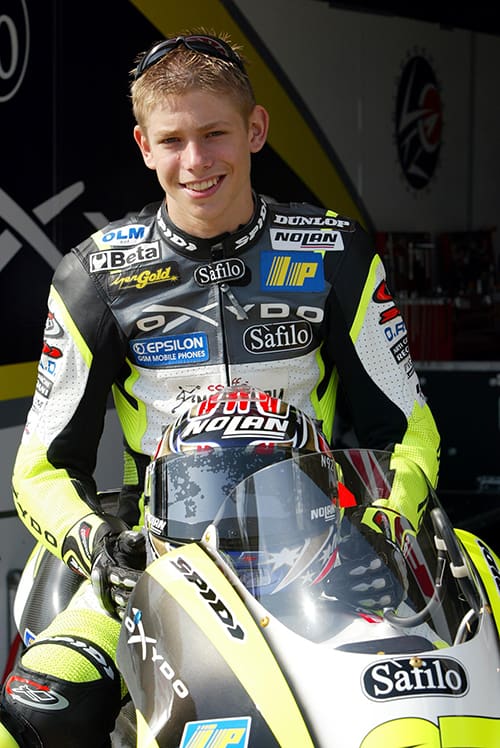
The Bike
APRILIA RSW250 (RACED IN 2002 & 2005)
Aprilia’s twin-crank V-twin evolved from the Austrian Rotax of the 1980s. That was a parallel tandem twin; Aprilia splayed out the cylinders for better weight distribution, and a long-lived design was born. Loris Reggiani won its first race in 1987. A similar evolution was still winning races when the 250 class ran out of time in 2009. It had a reputation for being finicky and unforgiving. One reason was the very stiff fabricated alloy chassis, which evolved into a curvaceous work of art. More so the disc-valve engine. Both torquier and more powerful than the reed-valve Japanese bikes, it was sudden and snappish in response. Needed careful handling to bring out its best.
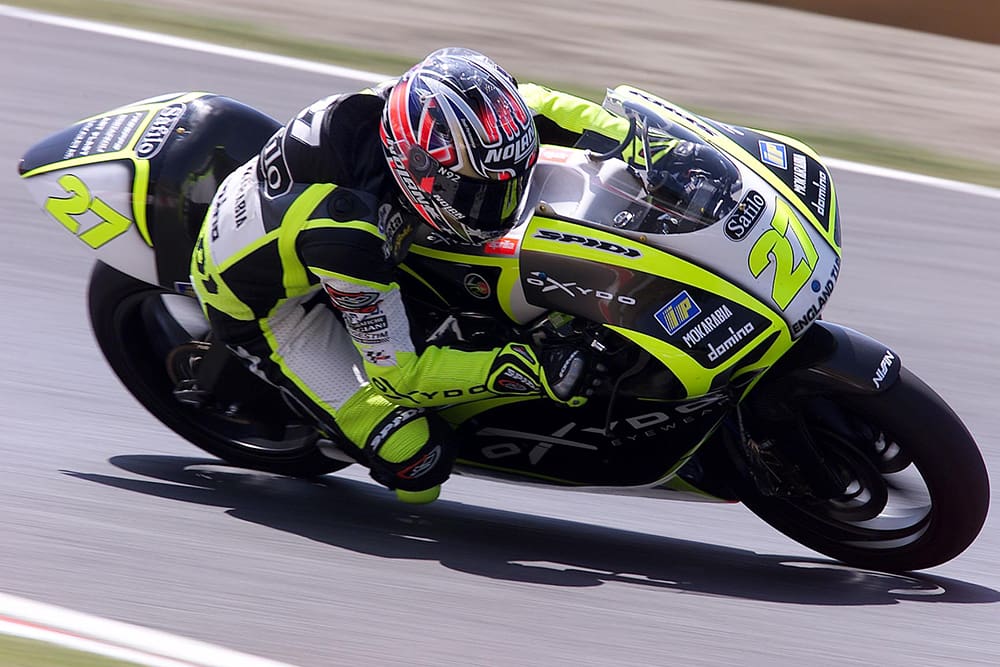
Back to 125s
SEASON 2003
Cecchinello brought Casey back to the 125 class, as his own teammate in his last year as a rider. They competed side-by-side, Stoner finishing eighth and Lucio ninth overall. Dani Pedrosa was champion; Casey took his first win, at Valencia.
“Halfway through that season we actually changed chassis, from one bike that we’d had that was one step down from a factory bike. At the Czech Republic, I crashed and broke my collarbone. After I returned I basically had a factory chassis, a string of podiums, and won the last race.
“A fantastic bike for me at the end of the season,” Casey says. “The only reason I didn’t have that chassis before is Lucio didn’t like it. When I was upgraded to the chassis he didn’t want I started to get some results.”

The Bike
2003 APRILIA RSW125
The half-size single-cylinder edition of the 250 was built on the same principles of design and construction. And was likewise a fast but edgy track companion, and a capable race winner… though not enough to stop Pedrosa’s Honda running away with the title. Casey came eighth. This model had the disc-valve conventionally on the end of the crankshaft, carb on the side. Later models had a skew-driven disc that allowed the carburettor to be mounted ahead of the cylinder, with a straight-line exhaust run.
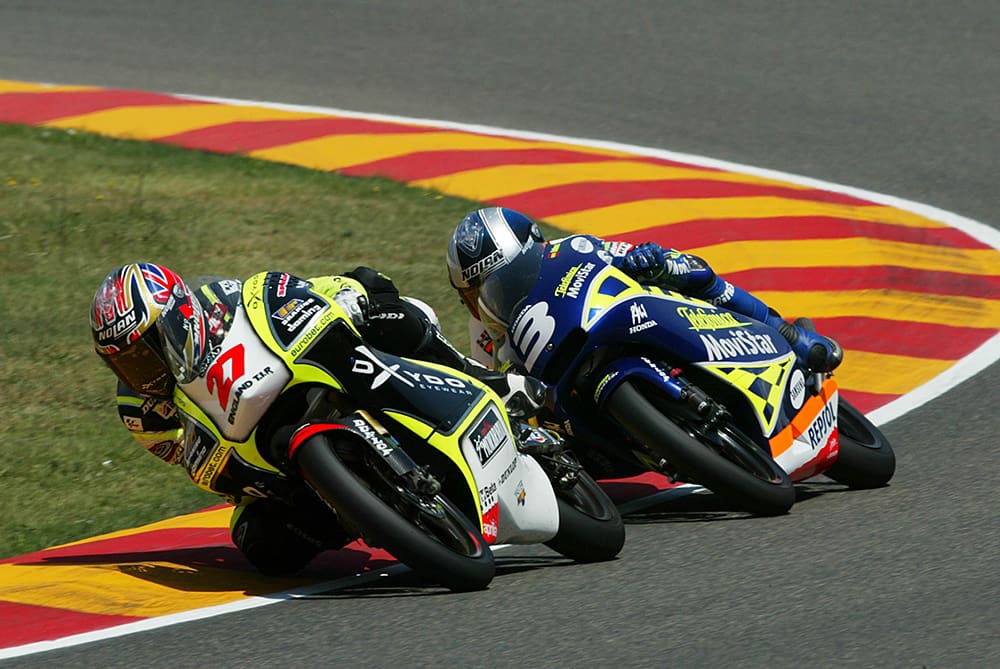
Factory Time
SEASON 2004
The Austrian bikes were back for a second year, with Stoner riding alongside Finn Mika Kallio. Casey’s reputation for speed was tempered by a bad crash record. Both were in evidence as he added one more win and finished fifth behind overall winner Dovizioso, easily outranking his teammate in a turbulent year.
“It changed a lot throughout the season,” Casey says. “We started with a fantastic engine, lots of control and very quick. We struggled a lot with the chassis, which was slowly developing. We worked a lot through the season and the chassis got better and better as it went on, but unfortunately our engine got worse and worse. We went from having one of the quickest bikes on the track to one of the slowest.
“I also had I think close to 40 seizures during that season. Just unbelievable. We struggled a bit with that, but I guess they rectified the situation for the next year.
“I only ever crashed once from a seizure, because I had my wrist taped up after I’d fractured it and had an operation, so I was a bit slow to get the clutch.”
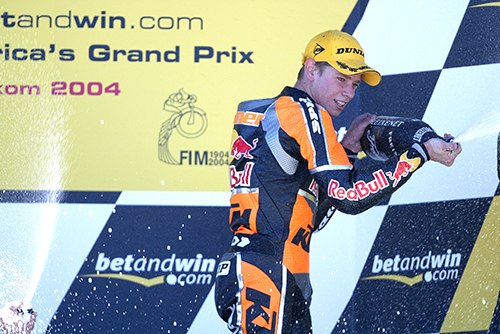
2004 KTM 125
Brainchild of long-standing two-stroke guru Harald Bartol, the full factory 125 single was conventional, but for Bartol’s special ideas. One such was electronic fuel injection, which not even Honda could get to work. It was only a partial system, in conjunction with a carburettor and a reed valve.
“It did what a power jet does, but that only works when the throttle is open. Casey used to bang down the gears but it never seized, because the injection provided some lubrication,” Bartol told me. Casey remembers it very differently. Twin-spar chassis, power now up to 55bhp (41kW), and its production-racer successors eventually formed the basis of the Red Bull Rookies Cup bikes.

Back to 250s
SEASON 2005
BIKE: APRILIA RSW250
Back with Lucio Cecchinello and teamed with ex-125 champ Roberto Locatelli, Stoner was also once again racing against long-time competitor Dani Pedrosa, on the top Honda. Also on hand were Andrea Dovizioso and Jorge Lorenzo. Casey and Dani fought it out for the title, in doubt until the closing stages. Casey won five races, Dani eight for his second title. They would meet again next year, in MotoGP.
“Again we were given a second-tier bike,” Casey laments. “We were making a pretty good run of it. We won a few times and were going fairly well. Made the odd mistake here and there, of course, but had some great races trying to get back towards the end of the season. I was pretty happy with the bike. It was fairly balanced – pretty much had the same bike from start to end of the season.
“Until basically I’d lost the championship in Phillip Island, then they decided to give me the go-fast parts. We got a couple more horsepower in the lower range, which was huge for us then… made the bike much easier to ride. But it was too little, too late.
“In general it was quite balanced, again similar to 2002 – quite tricky to ride and get it right on that fine point, but when you did it was a nice bike to ride.”
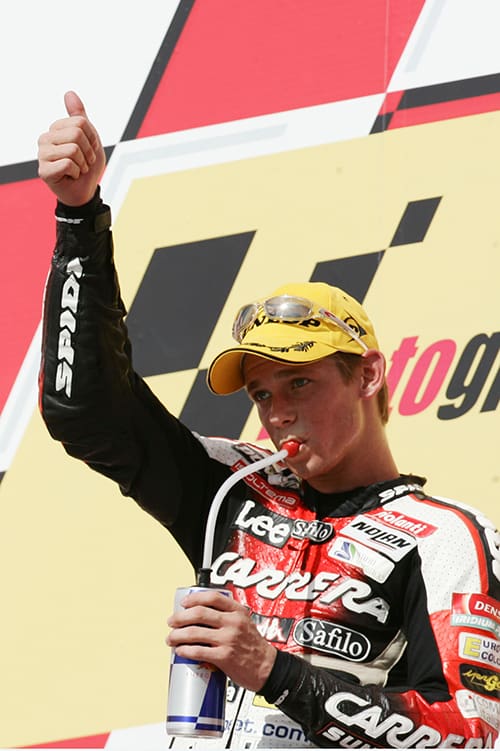

The Big Time
SEASON 2006
Lucio Cecchinello was ambitious, and the big class beckoned. He secured a lease Honda, signed up Casey, and the legend began to grow in the last year of the mighty 990s. Casey qualified on pole for his second race at Qatar and almost won the next race, finally beaten by Melandri by two 10hs after a cracking last-lap dice. It would be his only rostrum; he would later blame tyre skulduggery for a pattern that emerged: brilliant in qualifying, prone to crashing trying to match it in the race. Eighth overall as Nicky Hayden took the factory Honda to overall victory.
“Almost to this day it’s probably the best bike I’ve ridden,” Casey says. “One of the most raw, especially of the MotoGP bikes. The five-cylinder was a fantastic machine. We were always happy with it.
“So many people complain there is no way you could win a championship on a satellite bike, but I don’t think it’s the truth. I think it is the team that wins the championship, not necessarily just the bike. That satellite bike I had from Honda I’ve no doubt you could win the championship on that.
“We struggled a little bit through the season, mainly with tyres, but the bike was one of the best if not the best of my whole career.”

2006 HONDA RC211V
The definitive 990cc GP machine; original and beautifully wrought. Chief innovation
was the 75.5° V5 engine, which needed no balance shaft, produced lots of usable power, and sounded fantastic. Satellite bikes like Stoner’s were one or more steps behind the factory machines, mainly in terms of updates and developments. But, for example, the production version lacked the steering-head angle adjustment of the works machines. Electronics included elements of fly-by-wire, but by today’s standards were basic. Twin-spar chassis was pure convention, Honda style.

One and Only
SEASONS 2007-2010
“I think anyone can sum them up by watching them,” Stoner smiles. “They’re pretty manic, to be honest. Very, very difficult and tricky to set up, but very, very rewarding when you do get it right. “I think too many people looked at the speed of those bikes and went, ‘They’re so fast, they’ve got to be easy to race.’ But every rider that’s got on them, they want a more manageable engine, a more manageable racebike. “I think you need to play to each bike’s strengths. That’s what we were able to do, I think, better than other people that ride for Ducati. We played to the strengths and tried to minimise the weaknesses, and the bike proved to be competitive. “I think there was only one year we weren’t fighting for the championship, which was 2010. Each of the other years we had a good shot until unfortunately I had my wrist torn to pieces in 2008, then got ill in 2009.”
The big change came in the last year, when the steel-trellis chassis was replaced by the carbon-fibre airbox/chassis that Rossi disliked so much. Stoner points out that it was a big improvement.
“Of course it was better, because otherwise we would have stuck with the trellis frame. For me there were too many negatives with the trellis that we were never able to solve and fix. Steel is too difficult to get the correct flex. With carbon we got the stiffness that we wanted, and it improved the bike all round.”
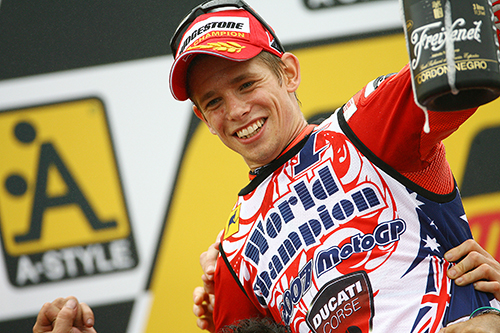
DUCATI DESMOSEDICI GP7-GP10
Quite apart from the drop in engine size from 990 to 800cc, pretty much everything was different about the Desmosedici. The engine was a 90° V, the front cylinder only slightly elevated from the horizontal, meaning a compromise between a desirable long swingarm and the need for a relatively short wheelbase. The chassis eschewed twin-beam orthodoxy for a trademark tubular steel trellis, which became more compact over the years. What made up for it in 2007 was a great leap forward in electronics meant the Ducati could still make lots of power while remaining within the new 21-litre fuel allocation. A world championship win in 2007 was the result.
The bike continued to evolve along the same lines until the great leap forward (if that was indeed the direction) of 2009: the replacement of the steel trellis frame with the carbon-fibre mini-chassis, which did double duty as an airbox. Although Stoner thought it an overall improvement, it was not until late in 2010, when they effectively moved the engine backwards and the rider forwards, that it became a more reliable race winner. At least, until Rossi got on board in 2011.

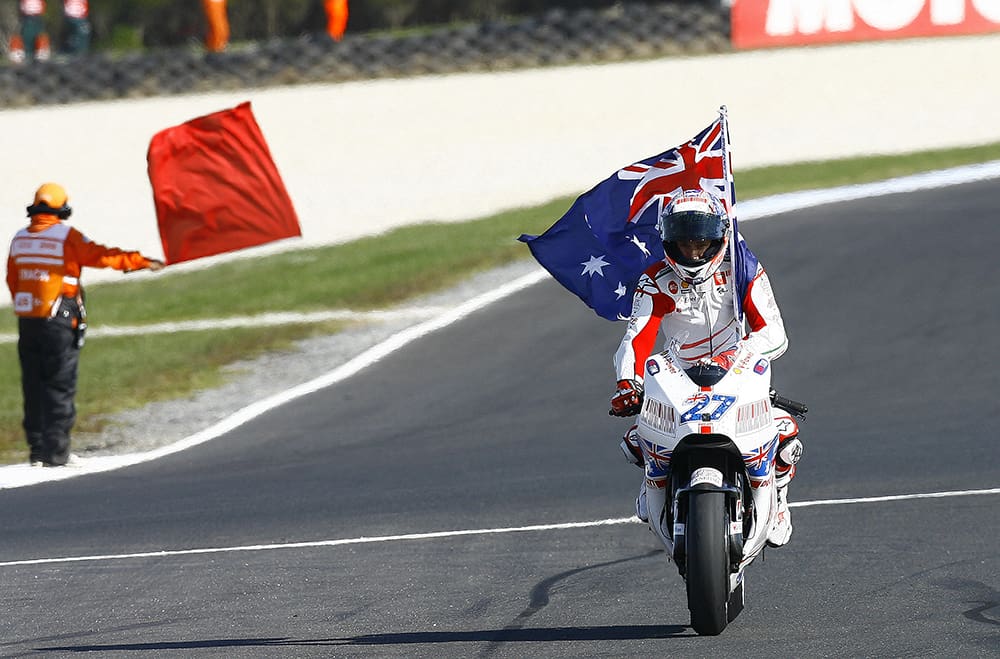
End of the Stoner era
SEASONS 2010-12
“The 800 was in my opinion a pretty good bike, but as soon as you look at it now against the 1000, the 1000 is so much smoother, so much easier to ride with torque,” Casey says. “The 800 was a little bit lighter to change direction, so it felt better and more nimble.
“But they’re very similar bikes in a lot of ways. There’s not too much difference between them, but I think the 1000 is one step forward a bit, in every single way. I was pretty happy with the 1000’s performance.
“I would call the Hondas a lot more refined than the Ducati. The Ducati was raw in a lot of ways and too much,
in my opinion. The Hondas are a lot more refined, so it’s a lot easier to find its point of balance, and there’s not as much difference between set-ups and things like this. So on that basis, it’s quite a lot easier.”

The Bike
2011 HONDA RC212V
Honda had dropped the fifth cylinder in the move from 990 to 800cc, and the transition had been troublesome. Endless chassis revisions – to stiffness, weight distribution and geometry – hadn’t helped chief rider Pedrosa to stem the tide of Yamaha, where Lorenzo had joined Rossi. In the last 800cc year, HRC was determined to win at least one title before the category was dropped. Development of the final iteration was intensive, and the 2011 RC212V found the perfect partner in Stoner, who revelled in its civil behaviour compared with the Ducati.
The Honda had always been powerful, and the latest chassis contained it better than previous nervier versions. There was a weakness in corner-entry stability, but Stoner was able to ride round that.
The biggest improvement compared with earlier versions was the still very secret seamless-shift gearbox, which provides an uninterrupted flow of torque through the entire speed range.

The Bike
2012 HONDA RC213V
After different chassis had been tested, the final version of the new 1000cc RCV was clearly a direct evolution of the 800. Obsessive secrecy meant details remained under wraps: HRC would not reveal the angle of the V4, leading to speculation putting it anywhere between 72 and 85°. But while HRC’s formula had remained constant, the tyres had changed, with Bridgestone offering a quicker warm-up with a softer construction. But it didn’t suit the Honda, generating chatter. Then an even softer carcass was introduced at the request of the majority of riders, and Honda’s problems became worse – even more chatter (oddly worse when turning left) and a queasy feeling on corner entry. A revised “2013” engine and chassis arrived mid-season, but team and engineers were still chasing chatter as the end of the season drew near.

